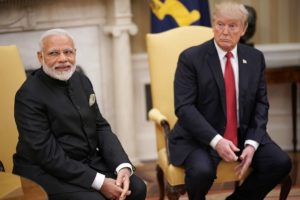Trade: Will India cede to the US?
Despite closer than ever strategic ties, all is not well with the trade relations between India and the United States. Even though India is a key market for US businesses and is a strategic political ally for the White House, the two sides are engaged in a damaging trade war.
India seems to to have joined the list of countries increasingly frustrated with US trade policy. India and the US have been embroiled in a series of disputes, including some at the World Trade Organization (WTO). India raised tariffs on import of 29 American products, valued at USD 238 million in response to the decision by Trump administration to levy 25 pc duty on certain steel products and 10 pc on aluminium products. The value of Indian exports impacted by these measures is USD 241 million.
To add fuel to the fire, reports suggest that the Trump administration may soon impose antidumping duty and countervailing duty on import of stainless steel flanges from India citing unfair pricing of these products. The US Department of Commerce on August 13 “determined that exporters from India have sold stainless steel flanges in that country at 19.16-145.25 pc less than fair value”.
The US has challenged almost all of India’s export programmes at the WTO saying they will harm its workers, citing the Agreement on Subsidies and Countervailing Measures (ASCM). It pegged the subsidies at USD 7 billion. The European Union, Russia, China, Japan and eight other countries have backed the US complaint against India’s export promotion schemes at the WTO. India’s exports to the US in 2017-18 were USD 47.9 billion, while its imports stood at USD 26.7 billion, leaving a trade deficit of about USD 21 billion and which seems to have upset President Donald Trump.
The dispute is not limited to trade. Intellectual property protection as well as ease of entry into Indian market are some of the concerns of the US businesses. Another issue is the Indian draft e-commerce policy. Foreign e-commerce firms, such as Amazon and also Walmart, complain that the policy is ‘heavily tilted’ against them. Amazon and Walmart, through its recent acquisition of Indian market leader, Flipkart, hold over 70 pc of the Indian e-commerce market share. In addition, a report by the United States Trade Representative lists a number of Indian policies that impose localisation restrictions.
Another issue that is potentially damaging to the ties is Iran. The US has asked India to cut its oil imports from Iran to ‘zero’ by November 4 or face sanctions. Iran is India’s third largest oil supplier, accounting for 20 million metric tonnes or 11 pc of Indian oil imports. India stands to lose a lot, especially as Iranian oil is amongst the most competitive of its imports and the two sides are likely to move away from dollar denominated trade in oil to escape the sanctions. India has said that its bilateral relations with Tehran stand on their own and are not influenced by its ties with any third country. Yet, cautious of a full-blown crisis in ties with the US, India has already reduced its purchases from Iran from 706,452 bpd to 203,938 bpd.
India’s purchase of S-400 missiles from Russia was another contentious issue. US had warned India to break all ties with Russia, which has historically been India’s largest defence supplier, with over 52 pc market share. In a bid to ease tensions with the US, the Modi government on August 25 decided to procure 24 MH-60R multi-role anti-submarine warfare helicopters from Lockheed Martin for the Indian Navy.
It may have calmed tensions, but the trade war and Iran are likely to be damaging to both the nations. For the US, India is not only an important growth market for the US corporations, but is also a strategic ally. As a damage control measure, the two sides agreed finally to hold the twice-deferred 2+2 strategic dialogue, between the defence and external affairs ministers of India and the United States. The dialogue will take place in New Delhi on September 6. Washington’s chief South Asia diplomat, Alice Wells, outlined a clear agenda for the inaugural 2 + 2 dialogue. Wells said that opening up trade with India was a “key strategic objective” for the Trump administration. “Tariff and non-tariff barriers have been a subject of long-standing concern and intellectual property rights as well. So we are continuing a very intensive dialogue with the Indian government on how do we address these irritants and unlock the trade that is of great interest to US firms when they look at the Indian market and its potential,” she said.
According to reports, the 2+2 talks will not only focus on developing and strengthening the strategic defence cooperation, but also address the critical issue of how India can get a waiver from the CAATSA (Countering America’s Adversaries Through Sanctions), which will hit Indian military imports from Russia and also the import of crude oil from Iran.
The strategic dialogue may help bring back the focus of both the nations on positives in their bilateral relationship and away from pain points which seem to dominate the landscape currently.










